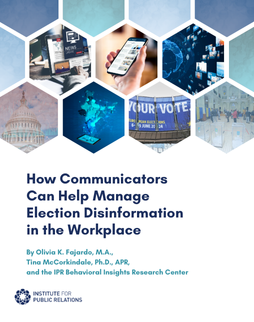With the advancement of immunization against COVID-19 and progress in vaccine coverage, a significant portion of the population has been vaccinated. In this context, several Brazilian companies have gradually returned to face-to-face work at their headquarters, which was in part adversely affected by the Omicron variant.
According to the 6th edition of this COVID-19 survey conducted by KPMG in Brazil, 40% of respondents thought that the return to in-person work would take place in the first half of 2022, compared to 8% who said the return would occur in the second half of the year. Among those surveyed, 37% stated that they will require the use of protective masks and hand sanitizer.
Return to the Office with COVID-19
Between the official communication of the return-to-office plan and the development of programs to help employees feel safe, a phenomenon has been present across several corporate channels: rumors and communication noise.
Rumors can be expanded and transmitted from person to person without there being concrete data to prove the rumor’s accuracy. Scholars including Knapp (1944), Allport and Postman (1946), Peterson and Gist (1951), Fonseca (1986), Kapferer (1993), Ramon-Cor´wa (2008), Difonzo (2009), Sunstein (2010), Chapman (2014), Kahneman (2021) have produced several studies and reference works on the dissemination of rumors over the past 70 years.
Questions such as “Will everyone really wear a mask?” “Will I need to wear a mask all day?” and “What happens if someone gets COVID and goes to work sick without warning?” fill chat groups of Brazilian teams on WhatsApp. So far, everything seems normal. However, risks occur when companies even know the existence of such doubts, fears, and anxieties and ignore them or do not respond. This creates a barrier in communication, which enhances the spread of rumors, instead of relieving them.
What Leads to the Formation of Chains of Rumors?
Just as non-adherence to vaccines increases the propensity to develop the most serious forms of various diseases, when a company does not invest in so-called communication with employees (formerly internal communication), it becomes vulnerable to chains of contagion of rumors, which originate as small noises that grow, multiply, and spread throughout the company.
According to a survey conducted by Aberje in 2020, the lack of face-to-face contact can be considered a problem when communicating with employees. 43% of participants said that this area would be the focus of investments in 2021. On the other hand, the existence of more “messages” does not always mean a more efficient communication process.
How to Manage Rumors in Organizations
The sociologist Edgar Morin considers that rumors travel a fast path, from the transmitter to its chain of transmission, having three phases in its cycle: incubation (when, in the face of an ignored doubt, it is born), propagation (if spreads quickly through the company), and metastasis (it dies, being fought with information and answers to doubts).
Among the factors that contribute to its rapid transmission are fear of layoffs, lack of assertive information in view of doubts and conflicts, and lack of interest on the part of the leadership in listening to the teams’ claims. These factors are enhanced by the loss of trust, the emergence of a climate of insecurity, and strengthening of so-called informal communication networks.
Eliminating Rumors
Although most Brazilian authors point out that it is not possible to have completely rumor-free companies, Chapmam recommends that[GGE4] , in order to reduce the ‘fertile soil’ for them to spread, it is necessary: first, to identify their source of origin (a sector, for instance, where there were layoffs), manage them, invite those involved to an open dialogue, create a communication program with employees, and work on transparency and trust in leadership, encouraging exchanges and feedback, instead of ‘separating’ even more those who already are in a context of doubt and anxiety, due to lack of information.
Dialogue and Transparent Communication
Communication is a process of dialogue that goes beyond informing and sending messages. Therefore, if your company wants to have healthy communication and develop antibodies against rumors, or mitigate their dangerous consequences, encourage a culture of feedback among teams and leaders, promote content and campaigns that involve the employee first hand, and partner with ambassadors and internal influencers. After all, behind every hearsay, there is a ‘need to know’ warning sign.
So, with these tips, is it possible to eliminate corporate rumors once and for all? I find it unlikely, since, as we already know, they are as human as breathing. What we can, must and is within our reach is to understand the motivations that gave rise to it, how it spread, circulated and what impacts it has on organizations, by mapping the degrees of noise and possible risks.
Isabela Pimentel is a consultant at Comunicacao Integrada in Brazil. She has a master’s in communication with specializations in Management and Projects. She is currently developing research on the impact of rumors on organizations.



